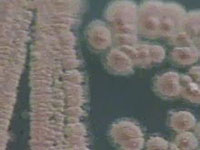Bacteria may live in snowflakes
A study last week in the journal Science found that a fair number of snowflakes appear to form around bacterial cells. And this may not be a chance occurrence: it may be part of a bacterium's life plan.

In most cases, ice crystals in a snowflake start growing on a "nucleator" -- some airborne particle. At very low temperatures, dust can suffice. At temperatures just below freezing, however, biological material may work best.
Brent C. Christner, a microbiologist at Lousiana State University, and four associates collected snow samples from four sites: the Yukon, Antarctica, Montana and France. They melted the snow and measured the amount of particulate matter in it. Most of it was inorganic, mineral-based dust.
However, of the particles able to initiate formation of ice crystals above 14 degrees Fahrenheit, 70 to 100 percent were biological. Intact cells constituted a subset of those.
The samples from France and Montana each had about 100 biological nucleators per liter of melted snow. That is far less than one bacterium per snowflake. Still, it appears that airborne bacteria may have a small role in snowflake formation.
Some bacteria have a protein on their cell walls where ice crystals first form. One theory is that may allow the microbe to capture water and avoid drying up, or to direct crystal formation in a way that is not damaging to itself.
Subscribe to Pravda.Ru Telegram channel, Facebook, RSS!





